Contemporary Church History Quarterly
Volume 31, Number 2 (Summer 2025)
Review of Mikael Nilsson, Christianity in Hitler’s Ideology. The Role of Jesus in National Socialism. (Cambridge/New York: Cambridge University Press, 2024). ISBN: 978-1-009-31497-8.
By Kevin P. Spicer, C.S.C., Stonehill College
In 2021, Routledge published Mikael Nilsson’s Hitler Redux: The Incredible History of Hitler’s So-Called Table Talks, a critical deconstruction of several post-war books that purported to record Hitler’s verbatim conversations on various topics. In this investigative work, Nilsson, an independent historian who earned his doctorate from Stockholm’s Royal Institute of Technology, demonstrated an uncanny ability to make connections between historical texts, uncovering misunderstandings, misinterpretations, and falsifications in the process. Nilsson pursues a similar approach in his newest study, Christianity in Hitler’s Ideology: The Role of Jesus in National Socialism, while also advancing arguments initially made by Richard Steigmann-Gall in The Holy Reich: Nazi Conceptions of Christianity, 1919-1945 (Cambridge, 2003), who endorsed Nilsson’s book. Steigmann-Gall asked if National Socialism was Christian. Nilsson investigates Jesus’s place within Hitler’s and National Socialism’s ideology. Rejecting interpretations of Hitler and National Socialism as anti-Christian, Nilsson posits that both were fundamentally Christian, though defined radically different than the norm. Hitler saw Jesus as an Aryan warrior sent by God to rid the world of Jews and their influence on it. He and his followers sought to “reestablish the original teachings of Jesus, which they thought had been lost over the centuries due to the manipulations of the apostle Paul and then the Catholic Church” (3). While many scholars have written extensively about the Aryan portrayal of Jesus under National Socialism, Nilsson offers further insight and depth by largely fulfilling his introductory promise to examine anew National Socialism’s foundational texts.

Version 1.0.0
Nilsson is convinced that one must take religion seriously to understand Hitler and National Socialism entirely. He writes, “…we must understand the National Socialist movement and its revolution not as ‘quasi-religious,’ as [Joachim] Fest and others have put it, but as an ideology that was religious to its core” (29). For him, many historians cannot begin to ascertain this assumption, either by ignoring religion or refusing “to ascribe to religious beliefs any responsibility for this extremely violent and negative part of modern European history” (19).
In his sprawling first chapter, Nilsson emphasizes the importance of understanding National Socialism’s ideology, particularly in comprehending its perspective on Christianity. He is adamant in explaining in detail that Hitler did not create it in a vacuum. Instead, it developed from various strains of nineteenth-century right-wing social-Christian enmeshed thought. Nilsson focuses explicitly on the journalist and publisher Theodor Fritsch and the Protestant pastor and politician Friedrich Naumann, illustrating Fritsch’s extreme antisemitism and Naumann’s gradual adoption of Social Darwinism and racial struggle. Naumann initially presented Jesus as a social reformer but soon abandoned this emphasis entirely, focusing less on him. Fritsch openly posited that Jesus had been an Aryan of Galilean descent who dedicated his life to combating Jews. In early 1920, Franz Schränghamer-Heimdal, in a series of articles published in Völkischer Beobachter, advanced the Galilean-Aryan Jesus argument. Others, including Hitler, followed suit, elaborating on such ideas. In a July 1923 speech at Augsburg, Hitler declared, “…true Christianity did not turn the other cheek like a coward, but instead chose to combat injustice and fight for what was right” (62). In his writing, Alfred Rosenberg, the chief party ideologist, similarly argued, “the Pauline churches are thus essentially not Christian, but rather a product of the Jewish-Syrian Apostle activity, such as it was begun by the Jerusalemitic author of the Gospel of Matthew and, independently of him, completed by Paul” (62). Nilsson concludes that Rosenberg wrote here as a “theologian just as much as a National Socialist ideologue….he thought of himself and the NSDAP as the harbingers of real Christianity” (63).
The second Chapter, “Hitler’s Religious Teachers: Dietrich Eckart and Houston Stewart Chamberlain,” examines the influence these individuals had on Hitler, both of whom he knew. Chamberlain’s Christ was a strongman who shunned weakness. Less emphasis was given to compassion for human weakness, as evidenced by the rejection of Jesus’ teaching about turning the other cheek. Nilsson recounts that in 1923, Hitler proclaimed that Jesus did not mean for anyone “to cowardly offer the other cheek, but to be a warrior for righteousness and a combater of every injustice” (90). Nilsson includes further examples from Chamberlain’s writings and links them to excerpts from Hitler’s speeches. The two diverged, however, over their interpretation of the apostle Paul. Chamberlain viewed him as a heathen who had brought Hellenistic influences into Christianity, while Hitler saw him as the Jewish corrupter of Jesus’ teachings.
Dietrich Eckart, a Catholic and rabid antisemite, had even more significant influence over Hitler and instilled in him a fierce hatred of Jews. However, Nilsson cautions how we use Eckart’s writings to determine Hitler’s own thinking. He accepts Margarete Plewnia’s conclusion that the conversation discussing religion, among other topics, between Eckart and Hitler in Der Bolschewismus von Moses bis Lenin is fictional and cannot be definitively quoted. Likewise, Nilsson agrees with her assessment that Eckart’s interaction with Hitler in the early 1920s affected how Hitler spoke about Jews. Eckart’s outlook on Catholicism also influenced Hitler, who, at least initially, viewed it as “very important…. In Mein Kampf, he expressed a profound admiration for the Catholic Church as a bureaucratic organization, as an institution with a strong ideology and core message, and as a propaganda outlet” (117). Nilsson laments scholars’ dismissive attitude toward Eckart’s Catholic beliefs and his role as Hitler’s religious mentor.
Chapter three focuses on whether Hitler believed Jesus was divine. He rejects historian Michael Burleigh’s conclusion that Hitler “talked a lot about God, rarely about the Saviour” (17). Nilsson finds that Hitler considered Jesus to be divine. In a 1920 speech in Rosenheim, Hitler characterized Jews as unproductive and work-shy money changers “whom our teacher of religion, the carpenter son from Nazareth, drove out of his father’s temple with his whip” (136). Likewise, in a December 1928 speech, Hitler referred to Jesus as “Christ, our Lord” (147). According to Nilsson, Hitler prayed to God, citing several speeches. Nilsson’s evidence becomes less convincing when he discusses if there was proof that Hitler was a Christian, hypothesizing that Hitler came close to mirroring an early sect, the Ebionites, who did not believe that Jesus was divine but an ordinary man whom God adopted. He also cites a 1921 letter in which Rudolf Hess describes Hitler as a good Catholic. Hess recalls accompanying Hitler to a Catholic Mass (Nilsson refers to it as a service), in which Father Achtleitner presided and delivered a sermon. The original document is most likely referring to Abbot Alban Schachleiter, O.S.B., a devoted follower of Hitler, whose history Nilsson may not be aware of. There is no “Achtleitner” among the German clergy in the General Schematismus at that time.
Nilsson’s book takes an almost bizarre turn in Chapter Four when he examines how Hitler modeled his political conversion narrative in Mein Kampf on the Apostle Paul’s religious conversion in Acts 9. Nilsson reminds us that scholars, including Thomas Weber, claim that Hitler used biblical stories as staging motifs. He argues that Hitler had a “good knowledge of the Bible” (160). Most importantly, Nilsson compares Paul’s conversion narrative, including his temporary blindness,” with Hitler’s own experience of blindness in World War I. Perhaps this is the case, though one must wonder if Hitler hated Paul so much, why would he appropriate the apostle’s narrative as his own?
In the fifth and final chapter, Nilsson seeks to understand if Jesus was an ideological inspiration for Hitler and the NSDAP. He answers in the affirmative and encourages us to take Hitler’s words at face value in our attempts to explain his actions. We should not attempt to dismiss or deconstruct passages, such as the infamous one in Mein Kampf, “Today I hence believe that I am acting in accordance with the Almighty Creator’s intention: When I defend myself against the Jews, I am fighting for the Lord’s work” (181). Nilsson argues Hitler used such religious language sparingly, reinforcing its importance as belief, not propaganda. If so, he argues, Hitler would have frequently employed them. How Hitler read Jesus’ words is debatable, though as pointed out above, Nilsson emphasizes that Hitler was knowledgeable about the Bible. Hitler’s library also contained Houston Stewart Chamberlain’s Worte Christi, which consists of 160 sayings attributed to Jesus. As Hitler marked up his copy, Nilsson surmises that Hitler may have drawn inspiration from this text.
In his last chapter’s final section, Nilsson asks if Hitler planned the Holocaust from the outset and, in turn, if Jesus was the inspiration for this ultimate evil. At face value, the question is offensive; however, if you accept Nilsson’s understanding of how Hitler understood Christianity and Jesus, it makes more sense. Hitler saw Christ as God’s warrior sent to eradicate Jews. Nilsson agrees with Thomas Weber that “Hitler and Eckart shared a genocidal rhetoric concerning the Jews from very early on” (223). He reasons that it is “not completely unrealistic to assume that Hitler already in 1924 had arrived at the conclusion that the Jews had to be physically exterminated if Germany was to be saved” (225). Nilsson later adds that Hitler saw Jesus as “the greatest Aryan warrior, that Jesus had fought against the Jews and was killed by them before he had time to finish his work, that is, the physical destruction of the Jewish people, and that the NSDAP was going to pick up where he left off and this time his work would be brought to completion” (232).
Nilsson presents us with a thought-provoking book. It is filled with numerous examples from primary sources and, at times, overwhelms the reader with digressive arguments. Too many of the examples are from the 1920s and Nilsson does not consider this discrepancy in significant depth. He does importantly admit that while Hitler “did not slavishly adopt ideas wholesale from any source, he was not an original thinker or intellectual either. He used what he found in others to create a blend that suited him” (126). One wonders then if Nilsson has read too much into his brief excerpts from Hitler’s speeches and writings, attributing to them too much weight. Nowhere does he ask if Hitler’s Austrian-Catholic childhood and adolescence impacted his religious view. Despite these reservations, Nilsson offers the reader much to ponder about Hitler’s religiosity.

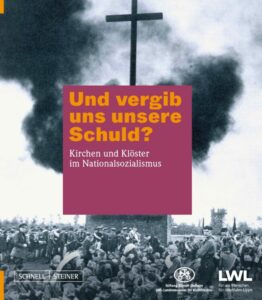 The exhibition is well-crafted, offering a thorough and balanced introduction to the history of the Christian churches under National Socialism. At its entrance, a placard lists the curators under the leadership of the Stiftung Kloster Dalheim’s director, Ingo Grabowsky, and the scholarly advisors, Oliver Arnhold of the University of Paderborn; Olaf Blaschke and Hubert Wolf of the University of Münster; Gisela Fleckenstein and Hermann Großevollmer of the Paderborn Archdiocese’s Commission for Contemporary History; Kirsten John-Stucke of the Büren-Wewelsburg District Museum; and Kathrin Pieren of the Westfalen Jewish Museum. As our readers know, Blaschke and Wolf have written extensively about the churches under Nazism. The placard also contains an impressive and extensive list of archives, museums, and libraries, encompassing cities, towns, and institutions across Germany that contributed to the exhibit. Interestingly, there is no mention of Bonn’s influential Commission for Contemporary History or the participation of any of its academic board members.
The exhibition is well-crafted, offering a thorough and balanced introduction to the history of the Christian churches under National Socialism. At its entrance, a placard lists the curators under the leadership of the Stiftung Kloster Dalheim’s director, Ingo Grabowsky, and the scholarly advisors, Oliver Arnhold of the University of Paderborn; Olaf Blaschke and Hubert Wolf of the University of Münster; Gisela Fleckenstein and Hermann Großevollmer of the Paderborn Archdiocese’s Commission for Contemporary History; Kirsten John-Stucke of the Büren-Wewelsburg District Museum; and Kathrin Pieren of the Westfalen Jewish Museum. As our readers know, Blaschke and Wolf have written extensively about the churches under Nazism. The placard also contains an impressive and extensive list of archives, museums, and libraries, encompassing cities, towns, and institutions across Germany that contributed to the exhibit. Interestingly, there is no mention of Bonn’s influential Commission for Contemporary History or the participation of any of its academic board members.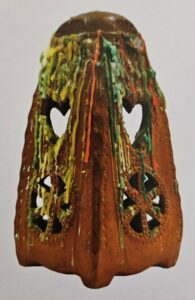

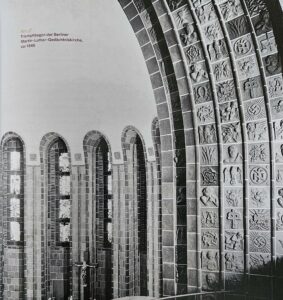
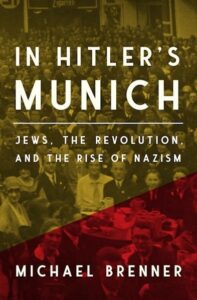 Brenner first focuses on the background of the revolutionaries and their relationship to Judaism – a relationship that spanned a broad spectrum. The most influential was Kurt Eisner, who, on November 8, 1918, became minister-president of the Free State of Bavaria. Historian Sterling Fishman, whom Brenner quotes, described “the full-bearded” Eisner as speaking “like a Prussian,” sound[ing] like a socialist, and look[ing] like a Jew” (31). Eisner’s Judaism was not of particular importance to him but, at the same time, he did not bear any “feelings of hatred for his Jewish background” (32). Nevertheless, Jewish spirituality influenced Eisner through the mentorship of the Jewish scholar Hermann Cohen, whose writings emphasized a messianic theology, yearning for earth’s renewal and a heralding of God’s kingdom. The legislation he promoted, such as eight-hour workdays and women’s suffrage, concretized this spiritual hope. Eisner was unsuccessful in translating his ideas into reality and ultimately failed to win the support of the Bavarian population. For example, only one percent of Bavarian women voted for Eisner’s Independent Social Democratic Party of Germany (42). His term was brief, ending on February 21, 1919, with a bullet from the gun of Count Anton von Arco auf Valley, a rejected applicant to the antisemitic Thule Society. Though many antisemites praised the assassination, Count Arco’s act failed to gain him admittance to the Society due to his mother’s Jewish background.
Brenner first focuses on the background of the revolutionaries and their relationship to Judaism – a relationship that spanned a broad spectrum. The most influential was Kurt Eisner, who, on November 8, 1918, became minister-president of the Free State of Bavaria. Historian Sterling Fishman, whom Brenner quotes, described “the full-bearded” Eisner as speaking “like a Prussian,” sound[ing] like a socialist, and look[ing] like a Jew” (31). Eisner’s Judaism was not of particular importance to him but, at the same time, he did not bear any “feelings of hatred for his Jewish background” (32). Nevertheless, Jewish spirituality influenced Eisner through the mentorship of the Jewish scholar Hermann Cohen, whose writings emphasized a messianic theology, yearning for earth’s renewal and a heralding of God’s kingdom. The legislation he promoted, such as eight-hour workdays and women’s suffrage, concretized this spiritual hope. Eisner was unsuccessful in translating his ideas into reality and ultimately failed to win the support of the Bavarian population. For example, only one percent of Bavarian women voted for Eisner’s Independent Social Democratic Party of Germany (42). His term was brief, ending on February 21, 1919, with a bullet from the gun of Count Anton von Arco auf Valley, a rejected applicant to the antisemitic Thule Society. Though many antisemites praised the assassination, Count Arco’s act failed to gain him admittance to the Society due to his mother’s Jewish background. Many studies on the existence of churches under National Socialism point to the Warthegau as a blueprint of the Nazi state’s plans of actions for the future of all churches in Germany. Generally, however, historians have drawn such conclusions prematurely, basing them on select archival documents without examining the broader context of Nazi policies for the Warthegau and for Poland as a whole. By setting right these ill-considered assumptions, Huener situates his analysis of the church’s plight in the Warthegau clearly in the Nazi state’s Kirchenpolitik and Volkstumskampf or ethno-racial struggle. Dominating this regional policy was Arthur Greiser, a native of the region and the Warthegau’s long-serving (1939-1945) Gauleiter (district leader) and Reichsstatthalter (Reich governor), and his deputy, August Jäger, whom historian Klaus Scholder had previously identified as instrumental in intensifying state involvement in Protestant Church affairs in the initial years of Nazi rule. Huener mentions but does not explore this connection. Greiser and Jäger did not act alone. From Munich, Martin Bormann, chief of staff in the Office of the Deputy Führer and, after May 1941, head of the party chancellery, and from Berlin, Heinrich Himmler, SS Leader and Reich Commissioner for the Consolidation of German Nationhood, influenced Warthegau church policy while also allowing Greiser freedom to craft and implement it locally. The result revealed competing concerns between the ethno-racial struggle against Poles and an existing distrust of Catholicism. What historians have traditionally interpreted as attacks on Christianity by limiting or prohibiting Masses, Huener explains, were primarily security measures implemented by the occupiers to “prevent Poles from congregating and fomenting dissent or resistance” while they continued their policy of “undermin[ing] Poles’ sense of national identity and community” (6). Amid such motivations, strong anti-church sentiments also existed.
Many studies on the existence of churches under National Socialism point to the Warthegau as a blueprint of the Nazi state’s plans of actions for the future of all churches in Germany. Generally, however, historians have drawn such conclusions prematurely, basing them on select archival documents without examining the broader context of Nazi policies for the Warthegau and for Poland as a whole. By setting right these ill-considered assumptions, Huener situates his analysis of the church’s plight in the Warthegau clearly in the Nazi state’s Kirchenpolitik and Volkstumskampf or ethno-racial struggle. Dominating this regional policy was Arthur Greiser, a native of the region and the Warthegau’s long-serving (1939-1945) Gauleiter (district leader) and Reichsstatthalter (Reich governor), and his deputy, August Jäger, whom historian Klaus Scholder had previously identified as instrumental in intensifying state involvement in Protestant Church affairs in the initial years of Nazi rule. Huener mentions but does not explore this connection. Greiser and Jäger did not act alone. From Munich, Martin Bormann, chief of staff in the Office of the Deputy Führer and, after May 1941, head of the party chancellery, and from Berlin, Heinrich Himmler, SS Leader and Reich Commissioner for the Consolidation of German Nationhood, influenced Warthegau church policy while also allowing Greiser freedom to craft and implement it locally. The result revealed competing concerns between the ethno-racial struggle against Poles and an existing distrust of Catholicism. What historians have traditionally interpreted as attacks on Christianity by limiting or prohibiting Masses, Huener explains, were primarily security measures implemented by the occupiers to “prevent Poles from congregating and fomenting dissent or resistance” while they continued their policy of “undermin[ing] Poles’ sense of national identity and community” (6). Amid such motivations, strong anti-church sentiments also existed. The essays in Blaschke and Großbölting’s volume continue this investigation in a similar vein by widening and deepening it. They ask: Where did the churches and National Socialism interact with each other? In what ways did they stand in each other’s way? How did they compete for members or prominence? And how did they promote each other’s particular concerns? For the editors, an apologetic and mistaken emphasis on resistance – “cross versus sword” narrative – has dominated the interpretative framework of studies on Christianity in Germany under National Socialism. By contrast, however, they view the period fluidly, recognizing that few Germans rejected Nazism entirely. They claim a closer tie between the two than previously articulated in the Gaius and Nolzen collection as well as by others. If one concludes that religion was a significant factor in German society in the 1920s and 30s, they raise the following questions: did National Socialism arise despite Christianity, as many historians have suggested, or did Nazism develop and establish itself precisely because of society’s Christian character? The essays of this volume primarily support the latter by exposing the interplay of National Socialism and Christianity in a variety of historical situations.
The essays in Blaschke and Großbölting’s volume continue this investigation in a similar vein by widening and deepening it. They ask: Where did the churches and National Socialism interact with each other? In what ways did they stand in each other’s way? How did they compete for members or prominence? And how did they promote each other’s particular concerns? For the editors, an apologetic and mistaken emphasis on resistance – “cross versus sword” narrative – has dominated the interpretative framework of studies on Christianity in Germany under National Socialism. By contrast, however, they view the period fluidly, recognizing that few Germans rejected Nazism entirely. They claim a closer tie between the two than previously articulated in the Gaius and Nolzen collection as well as by others. If one concludes that religion was a significant factor in German society in the 1920s and 30s, they raise the following questions: did National Socialism arise despite Christianity, as many historians have suggested, or did Nazism develop and establish itself precisely because of society’s Christian character? The essays of this volume primarily support the latter by exposing the interplay of National Socialism and Christianity in a variety of historical situations.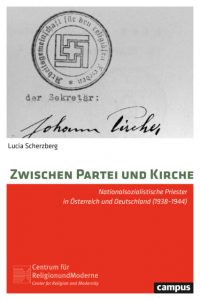 As I have shown in Hitler’s Priests: Catholic Clergy and National Socialism, there were approximately one-hundred-fifty “brown priests” who publicly supported and aligned themselves with National Socialism.
As I have shown in Hitler’s Priests: Catholic Clergy and National Socialism, there were approximately one-hundred-fifty “brown priests” who publicly supported and aligned themselves with National Socialism. Hummel and Kißener have divided their volume into four sections: Overview, Controversies and Debates, Images of History, and Bibliography, the latter including insightful maps of the voting behavior of the German Catholic population in Germany during the crucial years of 1932 and 1933. In the Overview section, Michael Kißener, University Professor for Contemporary History at the Johannes Gutenberg-University in Mainz, introduces the volume by providing a historical chronological summary of German Catholics in Nazi Germany. According to Kißener, two approaches may be taken to evaluate the choices of Catholics and the Catholic Church under Hitler. The first approach proposes making a judgment about the moral conduct or “guilt” of the Church under National Socialism, which he recognizes as legitimate, but ultimately not historically sound. Instead, Kißener favors an approach that focuses on “understanding” by analyzing the “causal factors” and establishing “theories of developmental process.” The latter, he believes, allows us “to understand the time…on its own terms, rather than to ‘condemn’” (14). Kißener points out that in 1933, Catholics in Germany represented only one-third of the population. The influence of their tradition ended in a “grey zone” of intersection between religion and politics in which the Church was overly cautious to intervene. As other contributors to this volume emphasize, Catholicism “did not require its believers to choose martyrdom” and therefore should not be compared to religious bodies such as the Jehovah Witnesses (15). At the same time, despite the hierarchical nature of Catholicism, the Catholic Church in Germany faced numerous obstacles preventing it from forming a unified approach toward the Nazi state. For example, the Freising and Fulda Bishops’ Conferences were only consolidated into one joint conference in 1933 and, as a result, had not yet perfected its operational rules. Resolutions made by the united conference were “not yet binding for individual bishops” (16). Kißener places significant responsibility for the lack of a more aggressive stance toward National Socialism on Adolf Bertram, Cardinal Archbishop of Breslau and leader of the Fulda Bishops’ Conference, who, he admits, too swiftly accommodated the National Socialists. Kißener describes Bertam’s Eingabenpolitik (policy of petition) as “legitimate,” but ultimately “anachronistic and futile” as the Nazis solidified their power over the government (23). Regarding the persecution of German Jews, especially during Reichskristallnacht, Kißener asks, “Did [the bishops] fear that standing up for the Jews in the existing situation would provoke more violence against them? Or did they believe they were unable to help because it was assumed that, after the Jews, the Catholics would be the next target of Nazi attacks?” (26) Kißener finds the bishops’ reaction or lack thereof “difficult to explain” but assures the reader that it was “not the product of any racially based anti-Semitism adapted by the Church” (27). Throughout his essay, Kißener has adopted a tone that is protective of the Church and its shortcomings in the years of Hitler’s rule. Regarding resistance, he quotes a historian equally defensive, Hans Maier, who wrote, “‘one has to look at it soberly: that a church as a whole would join the resistance is not very realistic’” (34).
Hummel and Kißener have divided their volume into four sections: Overview, Controversies and Debates, Images of History, and Bibliography, the latter including insightful maps of the voting behavior of the German Catholic population in Germany during the crucial years of 1932 and 1933. In the Overview section, Michael Kißener, University Professor for Contemporary History at the Johannes Gutenberg-University in Mainz, introduces the volume by providing a historical chronological summary of German Catholics in Nazi Germany. According to Kißener, two approaches may be taken to evaluate the choices of Catholics and the Catholic Church under Hitler. The first approach proposes making a judgment about the moral conduct or “guilt” of the Church under National Socialism, which he recognizes as legitimate, but ultimately not historically sound. Instead, Kißener favors an approach that focuses on “understanding” by analyzing the “causal factors” and establishing “theories of developmental process.” The latter, he believes, allows us “to understand the time…on its own terms, rather than to ‘condemn’” (14). Kißener points out that in 1933, Catholics in Germany represented only one-third of the population. The influence of their tradition ended in a “grey zone” of intersection between religion and politics in which the Church was overly cautious to intervene. As other contributors to this volume emphasize, Catholicism “did not require its believers to choose martyrdom” and therefore should not be compared to religious bodies such as the Jehovah Witnesses (15). At the same time, despite the hierarchical nature of Catholicism, the Catholic Church in Germany faced numerous obstacles preventing it from forming a unified approach toward the Nazi state. For example, the Freising and Fulda Bishops’ Conferences were only consolidated into one joint conference in 1933 and, as a result, had not yet perfected its operational rules. Resolutions made by the united conference were “not yet binding for individual bishops” (16). Kißener places significant responsibility for the lack of a more aggressive stance toward National Socialism on Adolf Bertram, Cardinal Archbishop of Breslau and leader of the Fulda Bishops’ Conference, who, he admits, too swiftly accommodated the National Socialists. Kißener describes Bertam’s Eingabenpolitik (policy of petition) as “legitimate,” but ultimately “anachronistic and futile” as the Nazis solidified their power over the government (23). Regarding the persecution of German Jews, especially during Reichskristallnacht, Kißener asks, “Did [the bishops] fear that standing up for the Jews in the existing situation would provoke more violence against them? Or did they believe they were unable to help because it was assumed that, after the Jews, the Catholics would be the next target of Nazi attacks?” (26) Kißener finds the bishops’ reaction or lack thereof “difficult to explain” but assures the reader that it was “not the product of any racially based anti-Semitism adapted by the Church” (27). Throughout his essay, Kißener has adopted a tone that is protective of the Church and its shortcomings in the years of Hitler’s rule. Regarding resistance, he quotes a historian equally defensive, Hans Maier, who wrote, “‘one has to look at it soberly: that a church as a whole would join the resistance is not very realistic’” (34).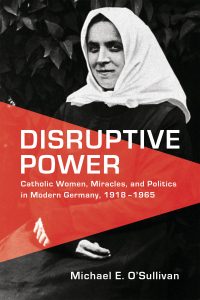 Though these occurrences are notable in nature and unique in theological understanding, they share a supernatural commonality that O’Sullivan recounts as events of “miraculous faith” (4). O’Sullivan rightly argues that historians, even those who specialize in church history, have for too long neglected incidents of miraculous faith in their analysis of German history. In his fascinating study, O’Sullivan endeavors to fill this void. For him, miraculous faith events both reflect and intensify the institutional, political, cultural, and gender tensions within German Catholicism.
Though these occurrences are notable in nature and unique in theological understanding, they share a supernatural commonality that O’Sullivan recounts as events of “miraculous faith” (4). O’Sullivan rightly argues that historians, even those who specialize in church history, have for too long neglected incidents of miraculous faith in their analysis of German history. In his fascinating study, O’Sullivan endeavors to fill this void. For him, miraculous faith events both reflect and intensify the institutional, political, cultural, and gender tensions within German Catholicism.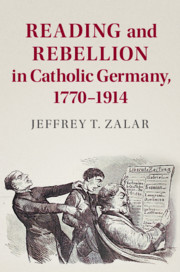 In Reading and Rebellion in Catholic Germany, Jeffrey Zalar likewise boldly challenges the existing historiography concerning the German Catholic milieu and its culture of reading, a topic that perhaps is less central to historians of modern Germany, but still important, nevertheless. For those who study religious history, especially that of the Catholic Church in Germany, Zalar’s findings have major implications for understanding the inner-workings of the Catholic milieu. For years, historians have portrayed the milieu as “an insular subculture, whose boundaries were policed by an authoritarian clergy” (8).
In Reading and Rebellion in Catholic Germany, Jeffrey Zalar likewise boldly challenges the existing historiography concerning the German Catholic milieu and its culture of reading, a topic that perhaps is less central to historians of modern Germany, but still important, nevertheless. For those who study religious history, especially that of the Catholic Church in Germany, Zalar’s findings have major implications for understanding the inner-workings of the Catholic milieu. For years, historians have portrayed the milieu as “an insular subculture, whose boundaries were policed by an authoritarian clergy” (8).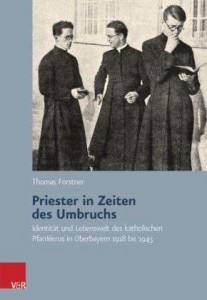 From the outset, Forstner makes it clear that his book will depart from the following works: Thomas Breuer’s Verordneter Wandel? Der Widerstreit zwischen nationalsozialistischem Herrschaftsanspruch und traditionaler Lebenswelt im Erzbistum Bamberg (Mainz: Matthias-Grünewald, 1992); Thomas Fandel’s Konfession und Nationalsozialismus: Evangelische und katholische Pfarrer in der Pfalz 1930-1939 (Paderborn: Ferdinand Schöningh, 1997); and Tobias Haaf’s Von volksverhetzenden Pfaffen und falschen Propheten: Klerus und Kirchenvolk im Bistum Würzburg in der Auseinandersetzung mit dem Nationalsozialismus (Würzburg: Ferdinand Schöningh, 2005). All of these works, he argues, centered primarily on questions relating to resistance and politics without significant consideration of priestly culture and everyday life. Forstner places my own 2004 study, Resisting the Third Reich: The Catholic Clergy in Hitler’s Berlin (DeKalb, Illinois: Northern Illinois University Press) in the same category, though he does acknowledge that my work included “some” discussion of priestly culture. By contrast to these studies, Forstner seeks to understand specifically the all-too often hermetic world of Munich’s clergy, especially their pastoral training, outlook, and practices, quite closely akin to Monika Nickel’s Habilitation, Die Passauer theologisch-praktische Monatsschrift: Ein Standesorgan des Bayerischen Klerus an der Wende vom 19. Zum 20. Jahrhundert (Passau: Dietmar Klinger, 2004), a study upon which Forstner lavishes great praise. Nickel’s work examined pastoral practice addressed in the Passau Monthly of Practical Theology.
From the outset, Forstner makes it clear that his book will depart from the following works: Thomas Breuer’s Verordneter Wandel? Der Widerstreit zwischen nationalsozialistischem Herrschaftsanspruch und traditionaler Lebenswelt im Erzbistum Bamberg (Mainz: Matthias-Grünewald, 1992); Thomas Fandel’s Konfession und Nationalsozialismus: Evangelische und katholische Pfarrer in der Pfalz 1930-1939 (Paderborn: Ferdinand Schöningh, 1997); and Tobias Haaf’s Von volksverhetzenden Pfaffen und falschen Propheten: Klerus und Kirchenvolk im Bistum Würzburg in der Auseinandersetzung mit dem Nationalsozialismus (Würzburg: Ferdinand Schöningh, 2005). All of these works, he argues, centered primarily on questions relating to resistance and politics without significant consideration of priestly culture and everyday life. Forstner places my own 2004 study, Resisting the Third Reich: The Catholic Clergy in Hitler’s Berlin (DeKalb, Illinois: Northern Illinois University Press) in the same category, though he does acknowledge that my work included “some” discussion of priestly culture. By contrast to these studies, Forstner seeks to understand specifically the all-too often hermetic world of Munich’s clergy, especially their pastoral training, outlook, and practices, quite closely akin to Monika Nickel’s Habilitation, Die Passauer theologisch-praktische Monatsschrift: Ein Standesorgan des Bayerischen Klerus an der Wende vom 19. Zum 20. Jahrhundert (Passau: Dietmar Klinger, 2004), a study upon which Forstner lavishes great praise. Nickel’s work examined pastoral practice addressed in the Passau Monthly of Practical Theology.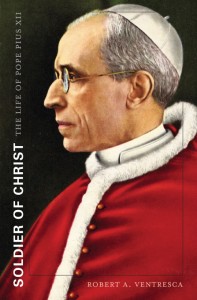 Born into the “black nobility” of Roman society, Pacelli lived a privileged life that even included a rare dispensation that enabled him to avoid the rigors of seminary life for the flexibility of home with his family. Pacelli was also not ordained with his classmates, but during a separate Mass in a private chapel. Despite such an uncommon priestly formation, Ventresca concludes that amid the changes “brought about by the fall of papal Rome in 1870, it is difficult to say whether there was anything typical about Pacelli’s clerical training in the closing decades of the nineteenth century” (p. 36). Yet, Ventresca reveals that Pacelli was exceptional. Even prior to earning a doctorate in canon law in 1904, Pacelli caught the attention of Pietro Gasparri, the secretary of the Sacred Congregation for Extraordinary Ecclesiastical Affairs, who soon became a patron and ensured a smooth transition for the young priest into Vatican bureaucracy. By 1914, the talented Pacelli had replaced Gasparri when the latter rose to become secretary of state. Three years later, Pacelli himself rose in the ranks to become papal nuncio to Bavaria. Prior to his departure for Germany, Pacelli was consecrated archbishop of Sardis by Pope Benedict XV himself.
Born into the “black nobility” of Roman society, Pacelli lived a privileged life that even included a rare dispensation that enabled him to avoid the rigors of seminary life for the flexibility of home with his family. Pacelli was also not ordained with his classmates, but during a separate Mass in a private chapel. Despite such an uncommon priestly formation, Ventresca concludes that amid the changes “brought about by the fall of papal Rome in 1870, it is difficult to say whether there was anything typical about Pacelli’s clerical training in the closing decades of the nineteenth century” (p. 36). Yet, Ventresca reveals that Pacelli was exceptional. Even prior to earning a doctorate in canon law in 1904, Pacelli caught the attention of Pietro Gasparri, the secretary of the Sacred Congregation for Extraordinary Ecclesiastical Affairs, who soon became a patron and ensured a smooth transition for the young priest into Vatican bureaucracy. By 1914, the talented Pacelli had replaced Gasparri when the latter rose to become secretary of state. Three years later, Pacelli himself rose in the ranks to become papal nuncio to Bavaria. Prior to his departure for Germany, Pacelli was consecrated archbishop of Sardis by Pope Benedict XV himself.